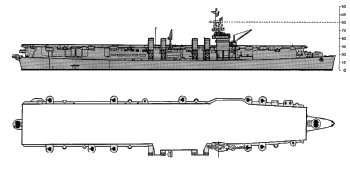![]() The Pacific War Online Encyclopedia
The Pacific War Online Encyclopedia
|
| Table of Contents |
 ONI 222 |
| Tonnage | 11,000 tons standard displacement |
| Dimensions | 619' by 71' by 24' 188.7m by 21.6m by 7.3m |
| Maximum speed | 31.5 knots |
| Complement | 1461 |
| Aircraft | 552' (168.2m) flight deck 2 H2 catapults 8 arrestor wires 2 elevators 30 aircraft |
| Armament | 2x4, 8x2 40mm
Bofors
AA guns 10x1 20mm Oerlikon AA guns |
| Protection | 254 tons: 5.5" (140mm) machinery belt tapering to 1.5" (38mm) (omitted from first two units) 2" (51mm) forward magazine belt 5" (127mm) bulkheads 2" (51mm) armor deck |
| Machinery |
4-shaft General Electric
geared
turbine (100,000 shp) 4 Babcock & Wilcox boilers |
| Bunkerage | 2686 tons fuel oil 110,000 gallons (416,000 liters) aviation gasoline |
| Range | 8325 nautical miles (15,400 km) at 15 knots |
| Munitions | 686.1 tons |
| Sensors |
SK
air
search radar SC-2 search radar |
| Modifications |
By 1945 all units had 26-28 40mm in twin and
quadruple mounts and SK-2, SP,
and
SPS-2 radar. |
The Independences
were completed in 1943. They
were an emergency measure, Cleveland-class
light cruiser
hulls converted to smaller fleet
aircraft carriers. The driving force behind their conversion was Roosevelt himself,
who
ignored the protests of his naval architects that the fine lines
of the
cruiser hulls would preclude a roomy hangar and large island and
make
it difficult to position the elevators or support the forward
flight
deck. A compromise design was developed that truncated the flight
deck,
included a very small island resembling those of escort carriers,
made do with
a rather small hangar, and bulged the hull to maintain stability.
This
required some modifications to the belt armor. Class A armor could
not
be easily welded to the blister frame, and class B armor could not
be
provided in time for the first two ships, which were completed
with no
belts to speed their
delivery to the fleet. The blisters were designed only for
stability
and the ships lacked any meaningful underwater protection.
The air group was typically 12 F6F Hellcat fighters, 9 TBM Avenger torpedo bombers, and 9
SBD Dauntless dive bombers, but in
practice
many more aircraft could be carried, if not efficiently operated.
As it turned out, they began entering
service at
almost exactly the same time as the Essexes,
which meant they never really played a crucial role in the war,
being
overshadowed by their larger and more capable sisters. They
had an
unusually hefty armor belt but
were
unable to operate large air groups
and
lacked the impressive 5"/38
batteries of the
larger carriers. By the end of the war they were being employed as
aircraft transports,
carrying up to 40 aircraft in their hangars and another 60 to 70
on
their flight decks.
Independence
herself completed with two 5"/38
DP
guns in place of the two quad 40mm guns.
|
Arrived 1943-6-25 |
||
|
Arrived 1943-7-18 |
||
|
Arrived 1943-8-1 |
Scuttled after air attack on 1944-10-22 off Samar in the Philippines | |
|
Arrived 1943-9-11 |
||
|
Arrived 1943-10-21 |
||
|
Arrived 1943-11-20 |
||
| Langley | Arrived 1943-12-14 | |
| Bataan | Arrived 1944-3-8 | |
| San Jacinto | Arrived 1944-3-8 |
 |
 |
 |
 |
 |
 |
 |
References
The Pacific War Online Encyclopedia © 2007, 2009, 2012, 2016 by Kent G. Budge. Index